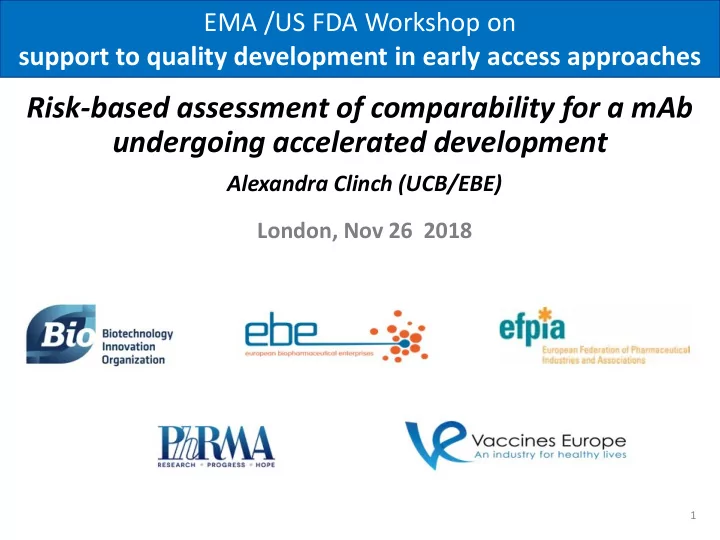

EMA /US FDA Workshop on support to quality development in early access approaches Risk-based assessment of comparability for a mAb undergoing accelerated development Alexandra Clinch (UCB/EBE) London, Nov 26 2018 1
Problem statement For an accelerated program, the comparability exercise may be on the • critical path due to changes late in development, therefore what is an appropriate amount of comparability given limited time and (potentially) limited pre-change data? – A comparability exercise for biotechnological/biological products follows the principles set out in ICH Q5E – Applicants tend to be conservative when performing comparability, performing a full comparability assessment, including extensive characterisation of the molecule – There should be a distinction between characterisation and comparability. The molecule will be fully characterised, but the comparability exercise should focus on the most relevant assays – Depending on the nature of the change(s) and the stage of development, a full comparability assessment may not be relevant, however the applicant must still ensure the quality, safety and efficacy of the post-change material 2
Case study This is an example of a mAb under the investigation for the treatment of a rare • disease, for which a platform non-optimized drug substance (DS) manufacturing process was used to progress to the first in man (FIM) study quickly The programme was further accelerated with ~9 months between FIM and • confirmatory study manufacturing campaigns Due to the molecular properties of the mAb, further development work was required to – optimize the process for commercial use It is not possible to use the clinical development facility for commercial manufacture due to – scheduling limitations, therefore the commercial process needs to be transferred to a CMO Due to the accelerated timelines, an optimized commercial process will not be ready and – available for transfer to the CMO in time for the start of the confirmatory study It is still intended to launch with the commercial material, therefore demonstration of – comparability between the clinical and commercial material is critical A risk-based approach has been developed to assess the extent of • comparability exercise for a particular change, with appropriate justification 3
Risk-based assessment of comparability Questionnaire used to assess: The potential of each individual change to impact quality attributes, for example: • Molecule – Primary structure • Glycosylation • Other post-translational modifications • Higher order structure • Biological activity • Impurity profile (process- and product-related) – Stability – Have product contacting materials changed? • Are there any device considerations? • The capability of the analytical methods to detect changes in the quality attributes • based on prior knowledge and forced degradation studies Are there any small scale data / platform data / prior knowledge that could support the • comparability exercise? Can the proposed comparability exercise confirm that the change does not impact • safety or efficacy? 4
Risk-based assessment of comparability continued... From this assessment, the overall analytical comparability package is determined, with • appropriate justification Relevant methods are selected for inclusion in the comparability exercise – e.g. peptide mapping with MS to confirm no impact to primary structure following change to • media/feeds Some analytical methods normally included in a full characterisation study may not be – considered necessary, depending on the particular change(s) e.g. for a scale change UCB would not perform the full range of higher order analyses. We • would use Circular Dichroism but not FTIR and fluorescence The stability package may be adjusted depending on the change – e.g. for a change from MCB to WCB, since there is no change to the cell line, the introduction of • the WCB is not expected to have an impact on quality attributes, therefore a stability study is not required for comparability exercise If necessary, clinical comparability will likely be assessed on a case-by-case basis • For accelerated programs, a clinical bridging bioequivalence (BE) study in healthy volunteers is – considered appropriate Typically, comparison of 3 pre-change and 3 post-change batches is expected. • For an accelerated product, the proposal is to perform comparability with fewer pre- and post- – change batches, potentially supported by small-scale data / platform data / prior knowledge This forms the pre-assessment of comparability. Following the exercise, if results are • inconclusive, further studies (analytical, nonclinical or clinical) may be required 5
Example of compound change – 5 changes made at the same time
Risk-based assessment of various changes Example Changes between processes CMC comparability package Studies excluded from CMC comparability based on risk assessment 1 DS: Full analytical comparability None Transfer to CMO • Scale-up DS release testing • • Replacement of non-optimal chromatography resin DS stability • • Change in formulation due to non-optimal stability DS in-process data • • Other minor changes to optimize commercial Full characterisation of molecule • • process using orthogonal methods DP: Forced degradation studies • Transfer to CMO only DP release testing • • DP stability • DP in-process data • Small scale studies where relevant • 2 DS: Reduced analytical comparability Full characterisation of molecule • Transfer to CMO Forced degradation studies • • Scale-up DS release testing • • DP: DS stability • Transfer to CMO only DS in-process data • • Reduced characterisation of • molecule focusing on predicted CQAs using relevant methods DP release testing • DP stability • DP in-process data • Small scale studies where relevant • 3 DS: Reduced analytical comparability DS release testing • No changes DS stability • • DP: DS in-process data DP release testing • • Increase in DP vial size Characterisation of molecule • • DP stability • Forced degradation studies • DP in-process data • 7 Small scale studies •
Acknowledgements UCB • – Alexandra Clinch – Annick Gervais – Carl Jone – David Kirke – John O’Hara – Agata Slopianka Biogen • – Richard Keane Amgen • – Andrew Lennard 8
Recommend
More recommend